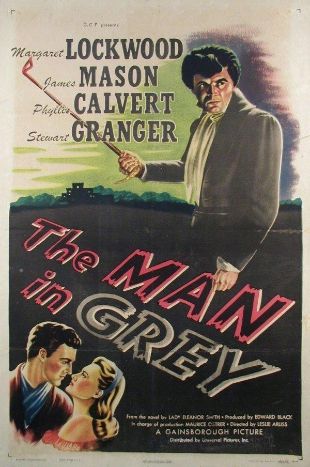
Looked at in the 21st century, Leslie Arliss' The Man in Grey, with its period setting and story of lordships and ladyships straying from marriage, seems like a quaint artifact of its era, a costume drama of no great import, apart from the compelling central performance by James Mason (who doesn't even appear until 25 minutes into the movie) and an attractive, dynamic portrayal by Stewart Granger. In its own time, however, the movie was considered a revelation to audiences the world over, and not least of all in England itself. That the British, and that most British of major studios -- the Rank Organisation -- could generate a movie that was as focused on dark (and darkly driven), libidinous, and lusty characters as this was astounding. And released in the dreary England of 1943, still fighting mostly a defensive war, and rapidly filling up with American soldiers, it was practically a license to print money; the movie wasn't even guilty escapist fare, as its opening and closing framing sequence brought the action right up to 1943 and the ongoing cost of the war. Even the last-minute change of heart by the Mason character, as he develops a conscience of sorts and a love for the wife he has lost, casts a reflection on the contemporary World War II setting of the opening. (The Lady Rohan, last of her line, whom we meet, is the descendant of the son that Mason's character prized so much and protected, and we've already learned that another descendant of that son died honorably at Dunkirk in 1940.) The script's combination of period detail and dark, lusty motivations for its characters enabled Mason, as well as Granger, Margaret Lockwood (previously known for playing good-natured, plucky heroines), and Phyllis Calvert all a chance to tap into aspects of their respective ranges that had been untouched onscreen, and show more than they'd ever been able to of their acting abilities, as well as a then-unusual charisma, growing out of the flawed natures they portrayed. The result, when laced with large dollops (for its time) of sadism, was a box-office bonanza and the elevation of all four lead actors to international star status.
Ironically, the one person not entirely happy with the results was J. Arthur Rank, the founder and head of the Rank Organisation, who realized the greatest profit of all concerned. A religious man by nature, Rank was troubled by the movie's apparent parading of amoral characters, and after a couple of follow-up efforts by Arliss, he pushed these overheated costumers (known in the trade as "Gainsborough" melodramas, for the production unit through which they were made) off the lot and out of his company. Today it is considered the best, if not the most entertaining of the Gainsboroughs, though The Man in Grey (as was the case with its follow-up, The Wicked Lady) was released in an edited version in the United States, shorn of 23 minutes of material -- and U.S. viewers should be aware that the one home-video release of the movie as of 2005, VidAmerica's 1980s VHS edition, is derived from that edited source.
